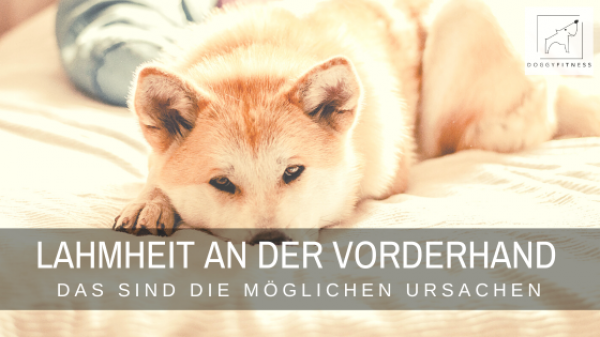When a dog is lame in the forehand, our first thought is that joint disease in the foreleg is the cause. This is by no means absurd and the first step should be to look for a cause.
Possible diseases that may be causative here
- One of the most common diseases of the forehand is elbow dysplasia. It usually shows the first symptoms within the first year of life. But of course, the first symptoms can also occur later.
- Furthermore, OCD of the shoulder may also be present. This is a typical young dog disease, which already causes the first symptoms between the 4th-9th month of life.
- Biceps tendon irritation or inflammation may also be present. This is very painful and causes significant lameness.
- Of course, basically any joint in the foreleg – from the shoulder to the toe joint – can also be affected by osteoarthritis.
The cause is not always immediately identifiable and must be found out by appropriate examinations.
But what to do if despite lameness on the forehand in the dog no cause can be found out? Lameness on the forehand in a dog
There is also the possibility that the origin of the lameness is not in the forehand at all. For example, a hip issue such as hip osteoarthritis or hip dysplasia can cause lameness in the forehand.
How can this be? Lameness on the forehand in a dog
One wonders, of course, if the affected dog should not then show lameness and discomfort in the back. It may even do so. Basically, however, the event can be explained in such a way that the dog tries to relieve his hip – to stay with this example – because it causes him discomfort. He does this by shifting increased load to the forehand. But more about that later. Lameness on the forehand in a dog
This is how the movement works in the healthy dog
First, to understand, let’s look at how locomotion works in a healthy dog. Simply put, the dog functions as a “rear-wheel drive”. This means he takes the thrust from the hindquarters. This is given forward over the spine. The forehand, respectively the shoulder girdle are mainly there to give stability.
Back to the lame dog
Now if we look again at our dog with hip problems, he is trying to relieve his hindquarters by putting more weight on his forequarters. The balance of the load distribution and also the function is disturbed. Because now the forehand is no longer primarily there to give stability. It must now also provide the drive.
This does not last long
Of course, the dog’s body makes a lot with and can “lift” this also a certain time. But at some point, the overload of the forehand will cause the first problems. The dog begins to limp. In the further course however muscular tensions develop due to the overloading, it can even in the case of doubt Arthrose be released.
So if you have a dog that is permanently lame in the front or every now and then in between, but you can’t find a cause for it, you should definitely consider the rest of the musculoskeletal system as well. Because the origin of a lameness does not always have to be found in the lame run. Once the cause has been found and treated or eliminated, the lameness of the forehand is usually under control again.
You see, it’s always important to look at the entire dog’s body if one area of the body is acting up, painful or altered. Lameness on the forehand in a dog
All the love, your Tina
Dieser Beitrag ist auch verfügbar auf:
Français (French)
Deutsch (German)
Español (Spanish)
















